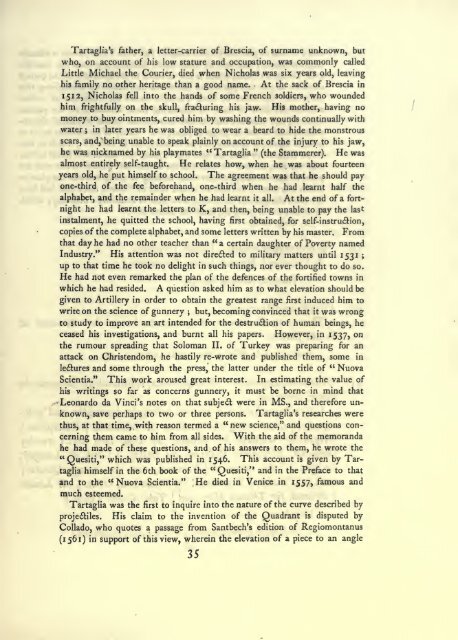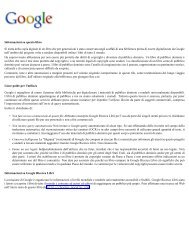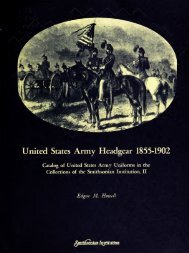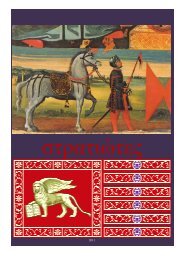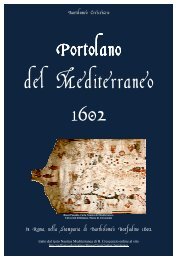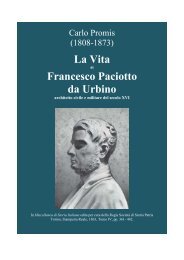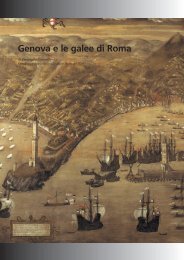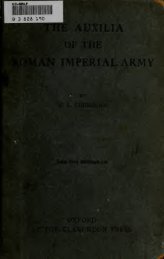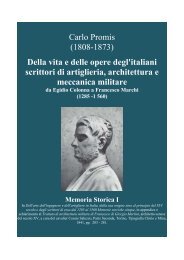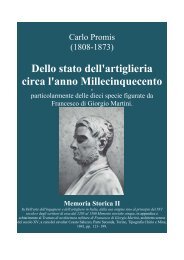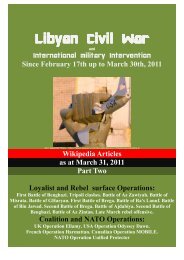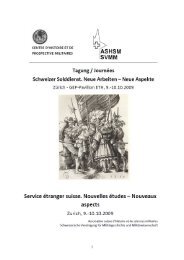A bibliography of English military books up to 1642 and of ...
A bibliography of English military books up to 1642 and of ...
A bibliography of English military books up to 1642 and of ...
You also want an ePaper? Increase the reach of your titles
YUMPU automatically turns print PDFs into web optimized ePapers that Google loves.
Tartaglia's fether, a letter-carrier <strong>of</strong> Brescia, <strong>of</strong> surname unknown, but<br />
who, on account <strong>of</strong> his low stature <strong>and</strong> occ<strong>up</strong>ation, was commonly called<br />
Little Michael the Courier, died when Nicholas was six years old, leaving<br />
At the sack <strong>of</strong> Brescia in<br />
his family no other heritage than a good name.<br />
1512, Nicholas fell in<strong>to</strong> the h<strong>and</strong>s <strong>of</strong> some French soldiers, who wounded<br />
him frightfully on the skull, frafturing his jaw. His mother, having no<br />
money <strong>to</strong> buy ointments, cured him by washing the wounds continually with<br />
water j in later years he was obliged <strong>to</strong> wear a beard <strong>to</strong> hide the monstrous<br />
scars, <strong>and</strong>, being unable <strong>to</strong> speak plainly on account <strong>of</strong> the injury <strong>to</strong> his jaw,<br />
he was nicknamed by his playmates " Tartaglia " (the Stammerer). He was<br />
almost entirely self-taught. He relates how, when he was about fourteen<br />
years old, he put himself <strong>to</strong> school. The agreement was that he should pay<br />
one-third <strong>of</strong> the fee beforeh<strong>and</strong>, one-third when he had learnt half the<br />
alphabet, <strong>and</strong> the remainder when he had learnt it all. At the end <strong>of</strong> a fortnight<br />
he had learnt the letters <strong>to</strong> K, <strong>and</strong> then, being unable <strong>to</strong> pay the last<br />
instalment, he quitted the school, having first obtained, for self-instrudion,<br />
From<br />
copies <strong>of</strong> the complete alphabet, <strong>and</strong> some letters written by his master.<br />
that day he had no other teacher than " a certain daughter <strong>of</strong> Poverty named<br />
Industry." His attention -wzs not directed <strong>to</strong> <strong>military</strong> matters until 1531 ;<br />
<strong>up</strong> <strong>to</strong> that time he <strong>to</strong>ok no delight in such things, nor ever thought <strong>to</strong> do so.<br />
He had not even remarked the plan <strong>of</strong> the defences <strong>of</strong> the fortified <strong>to</strong>wns in<br />
which he had resided. A question asked him as <strong>to</strong> what elevation should be<br />
given <strong>to</strong> Artillery in order <strong>to</strong> obtain the greatest range first induced him <strong>to</strong><br />
write on the science <strong>of</strong> gunnery ; but, becoming convinced that it was wrong<br />
<strong>to</strong> study <strong>to</strong> improve an art intended for the destruftion <strong>of</strong> human beings, he<br />
ceased his investigations, <strong>and</strong> burnt all his papers. However, in 1537, on<br />
the rumour spreading that Soloman II. <strong>of</strong> Turkey was preparing for an<br />
attack on Christendom, he hastily re-wrote <strong>and</strong> published them, some in<br />
lectures <strong>and</strong> some through the press, the latter under the title <strong>of</strong> " Nuova<br />
Scientia." This work aroused great interest. In estimating the value <strong>of</strong><br />
his writings so far as concerns gunnery, it must be borne in mind that<br />
•^<br />
Leonardo da Vinci's notes on that subjedl were in MS., <strong>and</strong> therefore unknown,<br />
save perhaps <strong>to</strong> two or three persons. Tartaglia's researches were<br />
thus, at that time, with reason termed a " new science," <strong>and</strong> questions concerning<br />
them came <strong>to</strong> him from all sides. With the aid <strong>of</strong> the memor<strong>and</strong>a<br />
he had made <strong>of</strong> these questions, <strong>and</strong> <strong>of</strong> his<br />
answers <strong>to</strong> them, he wrote the<br />
"Quesiti," which was published in 1546. This account is given by Tartaglia<br />
himself in the 6th book <strong>of</strong> the " Quesiti," <strong>and</strong> in the Preface <strong>to</strong><br />
<strong>and</strong> <strong>to</strong> the "Nuova Scientia." He died in Venice in 1557, famous <strong>and</strong><br />
much esteemed.<br />
Tartaglia was the first <strong>to</strong> inquire in<strong>to</strong> the nature <strong>of</strong> the curve described by<br />
projediles. His claim <strong>to</strong> the invention <strong>of</strong> the Quadrant is disputed by<br />
Collado, who quotes a passage from Santbech's edition <strong>of</strong> Regiomontanus<br />
(1561) in s<strong>up</strong>port <strong>of</strong> this view, wherein the elevation <strong>of</strong> a piece <strong>to</strong> an angle<br />
35<br />
that


